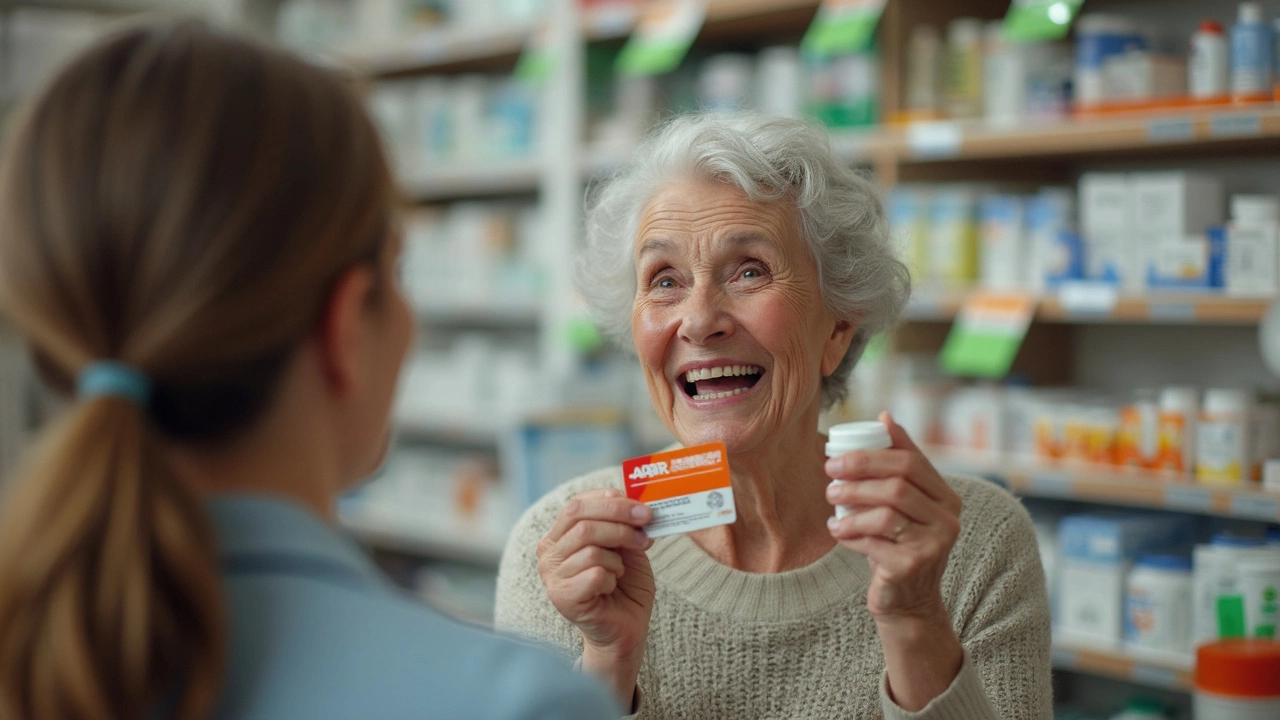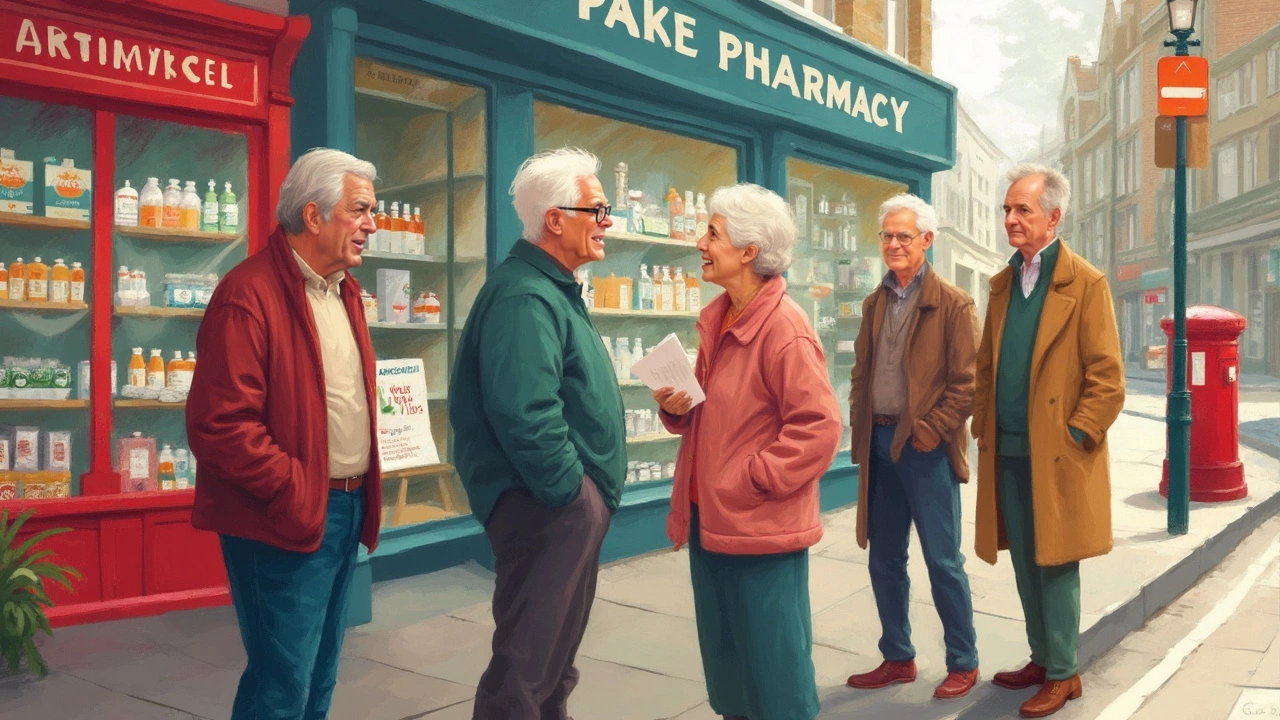 Jun, 8 2025
Jun, 8 2025
Swiping your AARP membership card at the pharmacy counter and watching your costs shrink sounds great, right? Most people over 50 have heard whispers about AARP offering prescription discounts, but it’s tough to know if those savings actually add up or if it’s just clever marketing.
AARP partners with a company called Optum Rx to provide a prescription discount card—free with your AARP membership. This card works at over 66,000 pharmacies across the U.S., including chains like Walgreens, CVS, Walmart, and plenty of local drugstores. You don’t need any special enrollment; your regular AARP card makes you eligible the moment you sign up as a member. You just show your AARP card or the Optum Rx discount card when you pay for your meds, and the discount automatically applies.
But how big are those discounts? On average, AARP claims members save around 61% off the retail price of FDA-approved prescription drugs. That sounds huge, but the real savings depend on the medication, pharmacy, and whether you’re buying a generic or brand name. Some folks save a ton on basic generics, while others find the price drop on name-brand meds isn’t all that impressive.
- What Is the AARP Prescription Discount Program?
- How The Discount Card Works
- Who Can Use AARP Discounts and Where?
- How Much Money Can You Save?
- Tips to Get the Best Price on Prescriptions
What Is the AARP Prescription Discount Program?
The AARP prescription discount program is basically a savings deal that helps you pay less for your meds at the pharmacy. It’s meant for AARP members, so you do need to join AARP to get in on the savings. Once you’re a member, you automatically get access to this program—no other sign-ups or hoops to jump through.
This setup is run through Optum Rx, a pharmacy benefits manager. The program isn’t insurance, but it can knock down your drug prices if you’re paying out of pocket, have a high deductible, or your insurance doesn’t cover a specific prescription. A lot of people use it when a medicine isn’t on their insurance plan, or if the discount is even bigger than their copay (yes, that sometimes happens!).
Here’s what you get with the program:
- Instant savings on FDA-approved prescription drugs at over 66,000 participating pharmacies nationwide.
- No health restrictions—you’re covered whether you’re on Medicare, have private insurance, or no insurance at all.
- Discounts are good on generics and brand-name drugs (but bigger savings usually come with generics).
- Your family members, even pets, can use the card if they’re covered under your AARP household membership.
- There’s an easy online tool to find the price of drugs at stores near you.
Curious about real numbers? Here’s a quick breakdown based on AARP’s and Optum Rx’s published data for 2024:
| Drug Type | Average Savings (%) |
|---|---|
| Generic | 68% |
| Brand Name | 34% |
Most savings show up on generics, so if your med has a generic option, you’ll usually benefit more. The program also works for mail-order prescriptions, which can cut prices even further for people with chronic needs.
There are no monthly fees for the AARP card beyond what you pay for your regular AARP membership. Plus, you don’t have to worry about age limits—AARP lets anyone 18 or older join, though most users are 50-plus.
How The Discount Card Works
The way the AARP prescription discount card operates is super straightforward, but there are a few details you should know. As soon as you become an AARP member, you get access to the Optum Rx prescription discount program—no need to sign up anywhere else or pay extra. Just show your AARP card or the Optum Rx card at checkout.
This discount card isn't insurance. It simply knocks down the cash price on thousands of meds at the register. If you have insurance, compare your insurer's copay with AARP's discounted price—sometimes the cash price is actually cheaper. Pharmacists can process whichever is lower, so don’t be shy about asking for both numbers.
Here’s how to actually use the card:
- Pick up your prescriptions at any participating pharmacy. That’s almost every big chain and most local shops—over 66,000 locations.
- Show your AARP membership card or Optum Rx discount card at checkout. If you don't have a physical card, the digital version from the member website works, too.
- The pharmacist rings up both your insurance price and the AARP discounted cash price. You pay the lower amount. There’s no paperwork or approval process.
Wondering how much you could save? Here’s a quick look at the average discount percentages reported by AARP:
| Type of Drug | Average Discount |
|---|---|
| Generic drugs | Up to 79% |
| Brand-name drugs | Up to 15% |
| Overall (all combined) | Roughly 61% |
The biggest deal here is the price break on generics. People who take common meds for things like high blood pressure, cholesterol, or diabetes usually see the biggest drop in price. But no matter what your medication, always compare what you’d pay with insurance, without insurance, and with your AARP prescription discount card. Sometimes the differences are surprising.

Who Can Use AARP Discounts and Where?
You don’t need to be a pharmacy expert or tech savvy to use the AARP prescription discounts program. If you’re an AARP member, you’re in. Age isn’t even a barrier—AARP lets anyone 18 or older sign up, though it’s mostly known for helping folks 50 and over. Once you’ve got your AARP membership, you automatically get access to the Optum Rx discount card; there’s no separate application or account for it.
Your family isn’t left out either. Here’s a cool perk: you can share your AARP prescription savings card with your spouse or anyone in your household. Just keep in mind, you aren’t allowed to use it for pets or for medications covered under your insurance or Medicare when the insurance is billed first. It’s best for out-of-pocket prescriptions—either those not covered by your insurance at all, or when you’re paying cash because your insurance price is higher than the AARP price.
Let’s talk locations. The card is accepted at huge chain stores like:
- CVS
- Walgreens
- Walmart
- Rite Aid
- Kroger
- Albertsons
- Publix
Don’t forget smaller chains and independent pharmacies—over 66,000 locations in total take the card nationwide. Whether you’re picking up meds in your hometown or you’re traveling across the U.S., chances are good a participating pharmacy is nearby.
Here’s a quick look at AARP’s reach by the numbers:
| Who Qualifies? | Where Can You Use It? |
|---|---|
| Anyone 18+ with AARP membership | 66,000+ pharmacies across the U.S. |
| Household members | Major big-box, grocery, and local pharmacies |
To check if your local pharmacy participates, you can use AARP’s website tool or just ask your pharmacist at the counter—they see these cards all the time.
How Much Money Can You Save?
When you hear about AARP prescription discounts, your first thought is probably: Will this actually help my wallet? The answer really depends on what meds you take and where you fill your prescriptions. Let’s look at what you can expect.
The big headline AARP and Optum Rx push is that members save up to 61% off retail prices. That’s an average across millions of transactions, not a guaranteed savings every time. Most members see their best results with generic drugs, which already cost less than brand-name options.
Here’s a quick snapshot of how the savings break down (all data comes from Optum Rx reports and pharmacy pricing in 2024):
| Prescription Type | Average Discount | Example Savings (30-day supply) |
|---|---|---|
| Generic | 60-80% | $25 drug drops to $8 |
| Brand Name | 15-30% | $150 drug drops to $120 |
Plenty of AARP members pay just a few bucks for popular generics, especially for things like blood pressure or cholesterol meds. But if you’re on specialty medication or new brand names, don’t expect miracle discounts. The card works best when insurance doesn’t cover your drug or you’re in a high-deductible phase.
Something that’s often missed: you don’t need to use insurance with the AARP card. Sometimes the discount is actually better than your co-pay! Always ask the pharmacist to check both prices. If the AARP price is lower, you just pay that and skip involving your insurance—no paperwork or claims needed.
Every pharmacy sets their prices, so it pays to shop around. You might find a giant difference from one spot to another, even with the same AARP card. If you want the best deal, use the official price lookup tool on the AARP or Optum Rx site to compare costs at different pharmacies near you before you fill your prescription.
The AARP prescription discount program is a lifesaver for some folks, especially if they’re between insurances, in the Medicare donut hole, or just picking up a med not on their insurance’s list. While it won’t make every med magically cheap, it’s often worth the quick check for unexpected price drops at the pharmacy counter.

Tips to Get the Best Price on Prescriptions
If you’re trying to pay less at the pharmacy, don’t just settle for the first offer you see. There are smart ways to really stretch your dollar when filling prescriptions, and sometimes the difference between options can actually be huge—like, 75% off huge. Here’s how to make sure you’re getting real value with your AARP membership and beyond.
- Always compare prices at different pharmacies. Chains like CVS, Walgreens, Walmart, and even local stores can all charge wildly different amounts for the same drug. Even with the AARP card, prices can vary by $10, $50, or more.
- Use online price checkers. AARP has an online tool with Optum Rx where you punch in your prescription and zip code to see actual costs before heading to the store. GoodRx and SingleCare are also great for comparison shopping—many users find these sites sometimes beat AARP’s discount by a few bucks, or even more.
- Ask your doctor about generic options. Generics almost always cost way less than name brands, sometimes more than 80% cheaper. The AARP card’s biggest discounts are often on generics, too.
- Double-check your insurance versus the card. Run both quotes. Weirdly, sometimes the non-insurance AARP discount price is less than your plan’s copay, especially for people with high-deductible plans or no insurance at all.
- Discount cards usually don’t stack. Don’t try to combine AARP, GoodRx, or plan discounts—it’s almost always one discount per transaction. Hand over all your cards, ask for the lowest, and make your pick.
- Try 90-day refills. Optum Rx and other pharmacy partners often offer bigger savings if you buy in bulk. A three-month supply can drop your per-pill cost compared to monthly fills.
For a quick look at how much you might actually save, check out this comparison chart based on real 2025 pharmacy prices for a few popular meds:
| Medication | Retail Price (CVS) | AARP Discount Price | GoodRx Price | Insurance Copay |
|---|---|---|---|---|
| Atorvastatin (generic Lipitor, 30 tabs) | $35 | $7 | $6 | $10 |
| Lisinopril (30 tabs) | $22 | $5 | $4 | $10 |
| Ventolin HFA (brand inhaler) | $78 | $63 | $62 | $65 |
| Metformin (60 tabs) | $19 | $4 | $5 | $9 |
Bottom line: Always do a quick check before you pay. That little bit of homework can easily keep $20, $40, or more in your pocket each month, no matter how you get your prescription discount.
